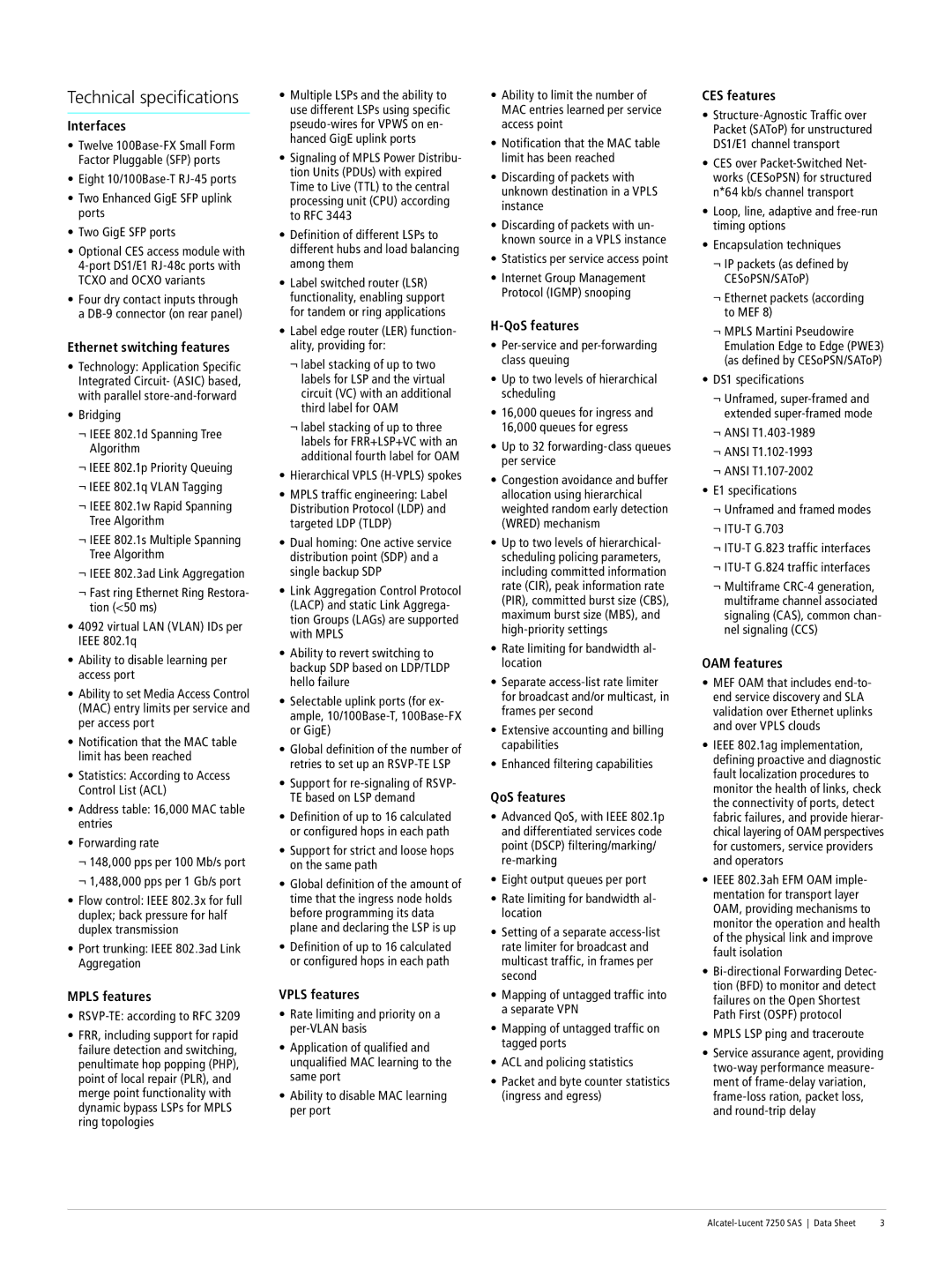
Technical specifications
Interfaces
•Twelve
•Eight
•Two Enhanced GigE SFP uplink ports
•Two GigE SFP ports
•Optional CES access module with
•Four dry contact inputs through a
Ethernet switching features
•Technology: Application Specific Integrated Circuit- (ASIC) based, with parallel
•Bridging
¬IEEE 802.1d Spanning Tree Algorithm
¬IEEE 802.1p Priority Queuing
¬IEEE 802.1q VLAN Tagging
¬IEEE 802.1w Rapid Spanning Tree Algorithm
¬IEEE 802.1s Multiple Spanning Tree Algorithm
¬IEEE 802.3ad Link Aggregation
¬Fast ring Ethernet Ring Restora- tion (<50 ms)
•4092 virtual LAN (VLAN) IDs per IEEE 802.1q
•Ability to disable learning per access port
•Ability to set Media Access Control (MAC) entry limits per service and per access port
•Notification that the MAC table limit has been reached
•Statistics: According to Access Control List (ACL)
•Address table: 16,000 MAC table entries
•Forwarding rate
¬148,000 pps per 100 Mb/s port
¬1,488,000 pps per 1 Gb/s port
•Flow control: IEEE 802.3x for full duplex; back pressure for half duplex transmission
•Port trunking: IEEE 802.3ad Link Aggregation
MPLS features
•RSVP-TE: according to RFC 3209
•FRR, including support for rapid failure detection and switching, penultimate hop popping (PHP), point of local repair (PLR), and merge point functionality with dynamic bypass LSPs for MPLS ring topologies
•Multiple LSPs and the ability to use different LSPs using specific
•Signaling of MPLS Power Distribu- tion Units (PDUs) with expired Time to Live (TTL) to the central processing unit (CPU) according to RFC 3443
•Definition of different LSPs to different hubs and load balancing among them
•Label switched router (LSR) functionality, enabling support for tandem or ring applications
•Label edge router (LER) function- ality, providing for:
¬label stacking of up to two labels for LSP and the virtual circuit (VC) with an additional third label for OAM
¬label stacking of up to three labels for FRR+LSP+VC with an additional fourth label for OAM
•Hierarchical VPLS (H-VPLS) spokes
•MPLS traffic engineering: Label Distribution Protocol (LDP) and targeted LDP (TLDP)
•Dual homing: One active service distribution point (SDP) and a single backup SDP
•Link Aggregation Control Protocol (LACP) and static Link Aggrega- tion Groups (LAGs) are supported with MPLS
•Ability to revert switching to backup SDP based on LDP/TLDP hello failure
•Selectable uplink ports (for ex- ample,
•Global definition of the number of retries to set up an
•Support for
•Definition of up to 16 calculated or configured hops in each path
•Support for strict and loose hops on the same path
•Global definition of the amount of time that the ingress node holds before programming its data plane and declaring the LSP is up
•Definition of up to 16 calculated or configured hops in each path
VPLS features
•Rate limiting and priority on a
•Application of qualified and unqualified MAC learning to the same port
•Ability to disable MAC learning per port
•Ability to limit the number of MAC entries learned per service access point
•Notification that the MAC table limit has been reached
•Discarding of packets with unknown destination in a VPLS instance
•Discarding of packets with un- known source in a VPLS instance
•Statistics per service access point
•Internet Group Management Protocol (IGMP) snooping
H-QoS features
•
•Up to two levels of hierarchical scheduling
•16,000 queues for ingress and
16,000 queues for egress
•Up to 32
•Congestion avoidance and buffer allocation using hierarchical weighted random early detection (WRED) mechanism
•Up to two levels of hierarchical- scheduling policing parameters, including committed information rate (CIR), peak information rate (PIR), committed burst size (CBS), maximum burst size (MBS), and
•Rate limiting for bandwidth al- location
•Separate
•Extensive accounting and billing capabilities
•Enhanced filtering capabilities
QoS features
•Advanced QoS, with IEEE 802.1p and differentiated services code point (DSCP) filtering/marking/
•Eight output queues per port
•Rate limiting for bandwidth al- location
•Setting of a separate
•Mapping of untagged traffic into a separate VPN
•Mapping of untagged traffic on tagged ports
•ACL and policing statistics
•Packet and byte counter statistics (ingress and egress)
CES features
•
•CES over
•Loop, line, adaptive and
•Encapsulation techniques
¬IP packets (as defined by CESoPSN/SAToP)
¬Ethernet packets (according to MEF 8)
¬MPLS Martini Pseudowire Emulation Edge to Edge (PWE3) (as defined by CESoPSN/SAToP)
•DS1 specifications
¬Unframed,
¬ANSI
¬ANSI
¬ANSI
•E1 specifications
¬Unframed and framed modes
¬
¬
¬
¬Multiframe
OAM features
•MEF OAM that includes
•IEEE 802.1ag implementation, defining proactive and diagnostic fault localization procedures to monitor the health of links, check the connectivity of ports, detect fabric failures, and provide hierar- chical layering of OAM perspectives for customers, service providers and operators
•IEEE 802.3ah EFM OAM imple- mentation for transport layer OAM, providing mechanisms to monitor the operation and health of the physical link and improve fault isolation
•
•MPLS LSP ping and traceroute
•Service assurance agent, providing
3 |
